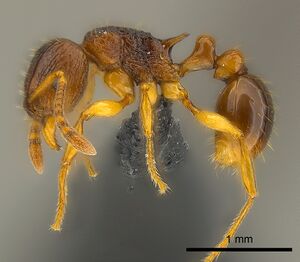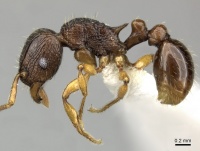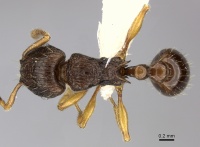Tetramorium vohitra
| Tetramorium vohitra | |
|---|---|

| |
| Scientific classification | |
| Kingdom: | Animalia |
| Phylum: | Arthropoda |
| Class: | Insecta |
| Order: | Hymenoptera |
| Family: | Formicidae |
| Subfamily: | Myrmicinae |
| Tribe: | Crematogastrini |
| Genus: | Tetramorium |
| Species: | T. vohitra |
| Binomial name | |
| Tetramorium vohitra Hita Garcia & Fisher, 2012 | |
The new species is currently only known from Andringitra. It was found in montane rainforests at high elevations of 1680 to 1990 m, and seems to live in the leaf litter stratum. (Hita Garcia and Fisher 2012)
Identification
A member of the Tetramorium dysalum-species group
Tetramorium vohitra can be separated from the remainder of the species group by the character combination of: short antennal scapes (SI 71 - 74); propodeal spines long (PSLI 28 - 31); petiolar node rounded high nodiform with anterodorsal and posterodorsal margins at approximately same height, dorsum not tapering backwards posteriorly; dorsum of mesosoma with distinctly, longitudinally arranged rugae; erect to suberect pilosity on first gastral tergite. (Hita Garcia and Fisher 2012)
Keys including this Species
Distribution
Latitudinal Distribution Pattern
Latitudinal Range: -22.16667° to -22.2°.
| North Temperate |
North Subtropical |
Tropical | South Subtropical |
South Temperate |
- Source: AntMaps
Distribution based on Regional Taxon Lists
Malagasy Region: Madagascar (type locality).
Distribution based on AntMaps
Distribution based on AntWeb specimens
Check data from AntWeb
Countries Occupied
| Number of countries occupied by this species based on AntWiki Regional Taxon Lists. In general, fewer countries occupied indicates a narrower range, while more countries indicates a more widespread species. |

|
Estimated Abundance
| Relative abundance based on number of AntMaps records per species (this species within the purple bar). Fewer records (to the left) indicates a less abundant/encountered species while more records (to the right) indicates more abundant/encountered species. |

|
Biology
Castes
Images from AntWeb
   
| |
| Queen (alate/dealate). Specimen code casent0192256. Photographer Estella Ortega, uploaded by California Academy of Sciences. | Owned by CAS, San Francisco, CA, USA. |
   
| |
| Paratype of Tetramorium vohitra. Worker. Specimen code casent0218034. Photographer Estella Ortega, uploaded by California Academy of Sciences. | Owned by CAS, San Francisco, CA, USA. |
Nomenclature
The following information is derived from Barry Bolton's Online Catalogue of the Ants of the World.
- vohitra. Tetramorium vohitra Hita Garcia & Fisher, 2012: 85, figs. 72, 83, 122-124 (w.) MADAGASCAR.
Unless otherwise noted the text for the remainder of this section is reported from the publication that includes the original description.
Description
Worker
HL 0.72 - 0.83 (0.78); HW 0.70 - 0.84 (0.78); SL 0.52 - 0.61 (0.57); EL 0.15 - 0.18 (0.17); PH 0.39 - 0.45 (0.42); PW 0.50 - 0.60 (0.55); WL 0.88 - 1.03 (0.96); PSL 0.21 - 0.25 (0.23); PTL 0.17 - 0.19 (0.18); PTH 0.30 - 0.35 (0.33); PTW 0.21 - 0.25 (0.23); PPL 0.22 - 0.26 (0.25); PPH 0.30 - 0.36 (0.34); PPW 0.31 - 0.36 (0.34); CI 97 - 101 (99); SI 71 - 74 (73); OI 20 - 22 (21); DMI 55 - 59 (57); LMI 41 - 44 (43); PSLI 28 - 31 (29); PeNI 39 - 44 (42); LPeI 51 - 58 (54); DPeI 120 - 138 (130); PpNI 58 - 65 (62); LPpI 71 - 75 (73); DPpI 131 - 143 (139); PPI 142 - 152 (147) (ten measured).
Head weakly wider than long to weakly longer than wide (CI 97 - 101). Anterior clypeal margin with distinct median impression. Frontal carinae well-developed, ending shortly before posterior head margin. Antennal scrobes weak, shallow, and narrow. Antennal scapes short, not reaching posterior head margin (SI 71 - 74). Eyes comparatively small (OI 22). Mesosomal outline in profile flat to weakly convex, moderately marginate from lateral to dorsal mesosoma; promesonotal suture absent; metanotal groove present but usually weakly developed; mesosoma comparatively stout and high (LMI 41 - 44). Propodeum armed elongate-triangular to spinose spines (PSLI 28 - 31); propodeal lobes short, triangular and acute. Petiolar node in profile rounded high nodiform, approximately 1.8 times higher than long (LPeI 51 - 58), anterior and posterior faces approximately parallel, anterodorsal and posterodorsal angles at about same height, dorsum not tapering backwards posteriorly; node in dorsal view 1.2 to 1.4 times longer than wide (DPeI 120 - 138). Postpetiole in profile approximately rounded, weakly anteroposteriorly compressed, approximately 1.3 to 1.4 times higher than long (LPpI 71 - 75), in dorsal view 1.3 to 1.4 times wider than long (DPpI 131 - 143). Postpetiole in profile approximately as voluminous as petiolar node, in dorsal view approximately 1.4 to 1.5 times wider than petiolar node (PPI 142 - 152). Mandibles finely longitudinally rugulose; clypeus with distinct median longitudinal ruga and one to three weaker rugulae at each side; cephalic dorsum between frontal carinae with eight to ten moderately regularly arranged longitudinal rugae, most rugae running unbroken to posterior head margin; lateral and ventral head reticulate-rugose to longitudinally rugose, except mostly unsculptured scrobal area; ground sculpture on head faint. Mesosoma laterally and dorsally longitudinally rugose, often with cross-meshes and sometimes moderately irregular, but main direction of sculpture distinctly longitudinal. Petiolar node, postpetiole, and gaster completely unsculptured, smooth, and shining. All dorsal surfaces of body abundant, moderately long, erect pilosity. Head, mesosoma, waist segments, and gaster of uniform brown colour, mandibles, antennae, and legs yellow to very light brown.
Type Material
Holotype worker, MADAGASCAR, Fianarantsoa, Rés. Andringitra, Anjavidilava Forest, 8.5 km SE Antanitotsy, 22.1667 S, 46.9667 E, 1990 m, upper limit of montane forest, sifted litter (leaf mold, rotten wood), collection code BLF01526, 6.III.1997 (B.L. Fisher) (California Academy of Sciences: CASENT0189167). Paratypes, three workers with same data as holotype except BLF01524 (CASC: CASENT0189168; CASENT0218031); two workers from Rés. Andringitra, 38 km S Ambalavao, 22.2 S, 46.9667 E, 1680 m, montane rainforest, canopy moss and leaf litter, collection code BLF01529, 24.X.1993 (B.L. Fisher) (CASC: CASENT0192260); and nine workers from Rés. Andringitra, 38 km S Ambalavao, 22.2 S, 46.9667 E, 1680 m, montane rainforest, sifted litter (leaf mold, rotten wood), collection code BLF00820, 23.X.1993 (B.L. Fisher) (The Natural History Museum: CASENT0247158; CASC: CASENT0218033; CASENT0218034; CASENT0218037; CASENT0260168).
Etymology
The epithet vohitra is Malagasy and means "hill", "village", or "mountain". The type locality is located at an altitude of almost 2000 m, and the name of the new species takes this high altitude into account. The species epithet is a noun in apposition and thus invariant.
References
References based on Global Ant Biodiversity Informatics
- Garcia H. F. and B. L. Fisher. 2012. The ant genus Tetramorium Mayr (Hymenoptera: Formicidae) in the Malagasy regiontaxonomy of the T. bessonii, T. bonibony, T. dysalum, T. marginatum, T. tsingy, and T. weitzeckeri species groups. Zootaxa 3365: 1-123

